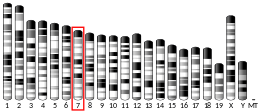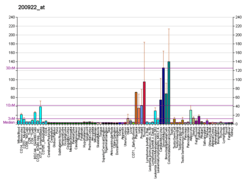KDELR1
KDEL (Lys-Asp-Glu-Leu) endoplasmic reticulum protein retention receptor 1, also known as KDELR1, is a protein which in humans is encoded by the KDELR1 gene.[1][2]
Function
Retention of resident soluble proteins in the lumen of the endoplasmic reticulum (ER) is achieved in both yeast and animal cells by their continual retrieval from the cis-Golgi or a pre-Golgi compartment. Sorting of these proteins is dependent on a C-terminal tetrapeptide signal, usually lys-asp-glu-leu (KDEL) in animal cells and his-asp-glu-leu (HDEL) in S. cerevisiae. This process is mediated by a receptor that recognizes and binds the tetrapeptide-containing protein and then returns it to the ER. In yeast, the sorting receptor is encoded by a single gene, ERD2, which is a seven-transmembrane protein. Unlike yeast, several human homologs of the ERD2 gene, constituting the KDEL receptor gene family, have been described. The protein encoded by this gene was the first member of the family to be identified, and it encodes a protein structurally and functionally similar to the yeast ERD2 gene product.[2] The KDEL receptor mediates the retrieval of misfolded proteins between the ER and the Golgi apparatus.[7] The KDEL receptor functions by binding to endoplasmic reticulum chaperones.[7] These chaperones are recognized by the KDEL receptor in downstream compartments of the ER. Once bound, they are packaged into coat protein complex I vesicles for retrograde transport to the ER.[8] In vitro studies in yeast have revealed that this receptor regulates membrane transport in the early stages of the secretory pathway from ER to the Golgi.[8] An error or mutation in the KDEL receptor disturbs the ER quality control and diseases associated with ER stress are observed.[9]
Dilated cardiomyopathy
KDEL receptors have been implicated in the development of dilated cardiomyopathy (DCM). To determine the relationship between KDEL receptor and dilated cardiomyopathy, transgenic mice with a point mutation (D193N) were made.[7] The mice expressing the transport mutant D193N gene grew normally until they reached adulthood. The mutant KDEL receptor did not function after 14 weeks of age, and these mice developed DCM. They were observed to have dilated heart chambers, as well as higher heart-to-body ratios with enlarged hearts, and the cardiac myocytes were larger in size.[7] No difference was observed in arterial blood pressure between wild-type and mutant mice, thus cardiomegaly was not attributed to hypertension.[7] Upon analysis, it was found that KDEL mutant mice had proliferation in their sarcoplasmic reticulum (SR) and a narrowing in the transverse tubule compared to the wild-type and controls. Moreover, aggregations of degenerative membrane proteins were observed in the expanded SR. This suggests that the mutant KDEL receptor leads to impaired recycling and quality control of the ER, which leads to aggregation of misfolded proteins in the ER. Furthermore, KDEL D193N transgenic mice had defects in the L-type Ca++ channel current in ventricular myocytes.[7] The basal current of these channels was significantly lower than the controls. L-type channels expression was lower in the plasma membrane of the KDEL D193N heart cells due to the narrowing of transverse tubules.[7] BiP, a chaperone protein, was unevenly distributed and synthesized in larger proportion in the transgenic mutant mice, which suggests that there was an increase in concentration of misfolded proteins.[7] They also observed aggregates of the ubiquitin-proteasome system (a degradation system); this suggests that there was saturation of the system due to the high levels of misfolded proteins that lead to impaired ER quality control.[7] The researchers concluded that hyperubiquitination and saturation of the proteasome system results due to the accumulation of misfolded protein, which induces stress.[7] The accumulation of misfolded proteins induced by ER stress has also been observed in human DCM.[10] A murine DCM study found an increase in apoptosis due to the high levels of CHOP expression. CHOP is a transcription factor that is elevated during ER stress and causes apoptosis of cells during the process of an unfolded protein response.[11] Increase pressure load/mechanical stress in KDEL D193N mice caused an even greater synthesis of BiP, CHOP and other proteins that are biomarkers of cellular stress and ER stress as the capacity of the ER to deal with this is very limited.[7]
Lymphopenia
KDELR1 is also critical for the development of lymphocytes. Mice with a Y158C missense mutation in Kdelr1 have reduced numbers of B and T lymphocytes, and a more susceptible to viral infection. [12]
Structure
The structure of Gallus gallus KDELR2 (Uniprot Q5ZKX9) has been solved in the Apo state, KDEL peptide-bound state, and bound to a synthetic nanobody[15]. Sequence identity between human KDELR1 and chicken KDELR2 is 84.4%.
References
- Lewis MJ, Pelham HR (November 1990). "A human homologue of the yeast HDEL receptor". Nature. 348 (6297): 162–3. Bibcode:1990Natur.348..162L. doi:10.1038/348162a0. PMID 2172835.
- "Entrez Gene: KDELR1 KDEL (Lys-Asp-Glu-Leu) endoplasmic reticulum protein retention receptor 1".
- GRCh38: Ensembl release 89: ENSG00000105438 - Ensembl, May 2017
- GRCm38: Ensembl release 89: ENSMUSG00000002778 - Ensembl, May 2017
- "Human PubMed Reference:". National Center for Biotechnology Information, U.S. National Library of Medicine.
- "Mouse PubMed Reference:". National Center for Biotechnology Information, U.S. National Library of Medicine.
- Hamada H, Suzuki M, Yuasa S, Mimura N, Shinozuka N, Takada Y, Suzuki M, Nishino T, Nakaya H, Koseki H, Aoe T (September 2004). "Dilated cardiomyopathy caused by aberrant endoplasmic reticulum quality control in mutant KDEL receptor transgenic mice". Molecular and Cellular Biology. 24 (18): 8007–17. doi:10.1128/MCB.24.18.8007-8017.2004. PMC 515036. PMID 15340063.
- Semenza JC, Hardwick KG, Dean N, Pelham HR (June 1990). "ERD2, a yeast gene required for the receptor-mediated retrieval of luminal ER proteins from the secretory pathway". Cell. 61 (7): 1349–57. doi:10.1016/0092-8674(90)90698-e. PMID 2194670.
- Townsley FM, Wilson DW, Pelham HR (July 1993). "Mutational analysis of the human KDEL receptor: distinct structural requirements for Golgi retention, ligand binding and retrograde transport". The EMBO Journal. 12 (7): 2821–9. doi:10.1002/j.1460-2075.1993.tb05943.x. PMC 413532. PMID 8392934.
- Weekes J, Morrison K, Mullen A, Wait R, Barton P, Dunn MJ (February 2003). "Hyperubiquitination of proteins in dilated cardiomyopathy". Proteomics. 3 (2): 208–16. doi:10.1002/pmic.200390029. PMID 12601813.
- Zinszner H, Kuroda M, Wang X, Batchvarova N, Lightfoot RT, Remotti H, Stevens JL, Ron D (April 1998). "CHOP is implicated in programmed cell death in response to impaired function of the endoplasmic reticulum". Genes & Development. 12 (7): 982–95. doi:10.1101/gad.12.7.982. PMC 316680. PMID 9531536.
- Siggs OM, Popkin DL, Krebs P, Li X, Tang M, Zhan X, Zeng M, Lin P, Xia Y, Oldstone MB, Cornall RJ, Beutler B (October 2015). "Mutation of the ER retention receptor KDELR1 leads to cell-intrinsic lymphopenia and a failure to control chronic viral infection". Proceedings of the National Academy of Sciences of the United States of America. 112 (42): E5706-14. Bibcode:2015PNAS..112E5706S. doi:10.1073/pnas.1515619112. PMC 4620900. PMID 26438836.
- Aoe T, Cukierman E, Lee A, Cassel D, Peters PJ, Hsu VW (December 1997). "The KDEL receptor, ERD2, regulates intracellular traffic by recruiting a GTPase-activating protein for ARF1". The EMBO Journal. 16 (24): 7305–16. doi:10.1093/emboj/16.24.7305. PMC 1170331. PMID 9405360.
- Majoul I, Straub M, Hell SW, Duden R, Söling HD (July 2001). "KDEL-cargo regulates interactions between proteins involved in COPI vesicle traffic: measurements in living cells using FRET". Developmental Cell. 1 (1): 139–53. doi:10.1016/S1534-5807(01)00004-1. PMID 11703931.
- Bräuer P, Parker JL, Gerondopoulos A, Zimmermann I, Seeger MA, Barr FA, Newstead S (March 2019). "Structural basis for pH-dependent retrieval of ER proteins from the Golgi by the KDEL receptor". Science. 363 (6431): 1103–1107. doi:10.1126/science.aaw2859. PMID 30846601.
Further reading
- Pelham HR (October 1996). "The dynamic organisation of the secretory pathway". Cell Structure and Function. 21 (5): 413–9. doi:10.1247/csf.21.413. PMID 9118249.
- Lewis MJ, Pelham HR (January 1992). "Ligand-induced redistribution of a human KDEL receptor from the Golgi complex to the endoplasmic reticulum". Cell. 68 (2): 353–64. doi:10.1016/0092-8674(92)90476-S. PMID 1310258.
- Lewis MJ, Pelham HR (November 1990). "A human homologue of the yeast HDEL receptor". Nature. 348 (6297): 162–3. Bibcode:1990Natur.348..162L. doi:10.1038/348162a0. PMID 2172835.
- Aoe T, Cukierman E, Lee A, Cassel D, Peters PJ, Hsu VW (December 1997). "The KDEL receptor, ERD2, regulates intracellular traffic by recruiting a GTPase-activating protein for ARF1". The EMBO Journal. 16 (24): 7305–16. doi:10.1093/emboj/16.24.7305. PMC 1170331. PMID 9405360.
- Smith JS, Tachibana I, Pohl U, Lee HK, Thanarajasingam U, Portier BP, Ueki K, Ramaswamy S, Billings SJ, Mohrenweiser HW, Louis DN, Jenkins RB (February 2000). "A transcript map of the chromosome 19q-arm glioma tumor suppressor region". Genomics. 64 (1): 44–50. doi:10.1006/geno.1999.6101. PMID 10708517.
- Matsuda A, Suzuki Y, Honda G, Muramatsu S, Matsuzaki O, Nagano Y, Doi T, Shimotohno K, Harada T, Nishida E, Hayashi H, Sugano S (May 2003). "Large-scale identification and characterization of human genes that activate NF-kappaB and MAPK signaling pathways". Oncogene. 22 (21): 3307–18. doi:10.1038/sj.onc.1206406. PMID 12761501.
- Yamamoto K, Hamada H, Shinkai H, Kohno Y, Koseki H, Aoe T (September 2003). "The KDEL receptor modulates the endoplasmic reticulum stress response through mitogen-activated protein kinase signaling cascades". The Journal of Biological Chemistry. 278 (36): 34525–32. doi:10.1074/jbc.M304188200. PMID 12821650.
- Bard F, Mazelin L, Péchoux-Longin C, Malhotra V, Jurdic P (November 2003). "Src regulates Golgi structure and KDEL receptor-dependent retrograde transport to the endoplasmic reticulum". The Journal of Biological Chemistry. 278 (47): 46601–6. doi:10.1074/jbc.M302221200. PMID 12975382.
- Breuza L, Halbeisen R, Jenö P, Otte S, Barlowe C, Hong W, Hauri HP (November 2004). "Proteomics of endoplasmic reticulum-Golgi intermediate compartment (ERGIC) membranes from brefeldin A-treated HepG2 cells identifies ERGIC-32, a new cycling protein that interacts with human Erv46". The Journal of Biological Chemistry. 279 (45): 47242–53. doi:10.1074/jbc.M406644200. PMID 15308636.
- Ewing RM, Chu P, Elisma F, Li H, Taylor P, Climie S, McBroom-Cerajewski L, Robinson MD, O'Connor L, Li M, Taylor R, Dharsee M, Ho Y, Heilbut A, Moore L, Zhang S, Ornatsky O, Bukhman YV, Ethier M, Sheng Y, Vasilescu J, Abu-Farha M, Lambert JP, Duewel HS, Stewart II, Kuehl B, Hogue K, Colwill K, Gladwish K, Muskat B, Kinach R, Adams SL, Moran MF, Morin GB, Topaloglou T, Figeys D (2007). "Large-scale mapping of human protein-protein interactions by mass spectrometry". Molecular Systems Biology. 3 (1): 89. doi:10.1038/msb4100134. PMC 1847948. PMID 17353931.




